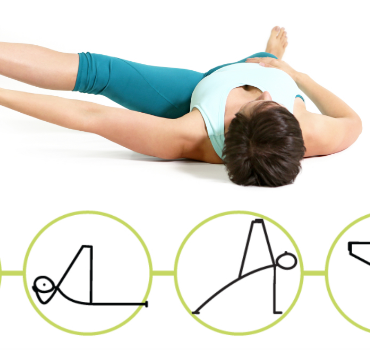How to keep your teaching fresh and inspired

Last week, one of my private clients said: “I must be your most boring client because I can’t do all the fancy, challenging stuff.” This made me think – what makes a yoga practice boring? Is it coming from the teacher or from the student? Is it dependent on speed? Variety? Quality of attention?
Well, if you as a teacher are bored or distracted while teaching and just go through the motions, your students will be bored and distracted, too. How can we keep our teaching fresh and inspiring even if we do it all day, every day? Here are some general ideas:
1. Seek out inspirational stuff. Inspiration is a finicky thing – you never know when it will strike you. What we can do is give inspiration a chance by reading interesting stuff that inspires, hanging out in nature, and doing other things that feed our soul. If you build potentially inspiring activities into your day, you will be more likely to receive that message when it comes.
2. Build your sangha or tribe. It always helps to hang out with people who are on the same journey as you are. We all know that some people inspire you, and other people drain you (my mom used to call those folks “energetic vampires”). So be sure to spend more time with folks who bring up the best in you and help remind you why you are doing this stuff in the first place. Talking through your accomplishments and your challenges with somebody who is in the same boat is both liberating and inspiring.
3. Maintain a consistent personal practice of self-exploration (consistent is a keyword here). I remember on the first day of my yoga teacher training, I overhead another teacher-trainee talk about her yoga practice: “I do an hour and a half asana practice in the morning and an hour of meditation in the evening every day.” Sheesh, I thought, my yoga practice is so inferior to this! Over the years, I came to realize that it is not about the length of the practice, it’s about potency and consistency. Got half an hour? Roll out your mat. Got 5 minutes? Do some centering breathing. The trick for me now is to do a little something every day and do it with presence and full attention.
4. Connect to the students. A fellow yoga teacher once told me that at the beginning of each class, she asks her students to center and deepen their breath while she closes her eyes and imagines drawing invisible links from her heart to the heart of each student. That image helped her feel connected to each person who was in the room and be there for them. You are likely to have your own way of connecting with your students; just make sure that you don’t skip that step when you teach.
5. Keep studying and experimenting with new ideas. I heard a fellow yoga teacher say once: “I have been teaching yoga for so long now, I don’t know if there is anything new I could learn about it.” This kind of made my jaw drop because I always feel the opposite – like there is so much to learn I don’t know how I can manage to understand and integrate even a little sliver of it. I like to think about it in an image of a spiral – in yoga, it seems like you often find yourself returning to the same ideas, but every time, it is on a slightly different level – not because the ideas change, but because you change, explore, grow. And this is what studying (and gaining experience) does – it helps us see the same things in a new light.
6. Take time to revisit with your own teacher. There is nothing like being in the presence of a yoga teacher who is “plugged in,” meaning connected to the tradition and immersed in his own practice. Regular contact with a teacher like that will elevate your teaching and support you on your own journey.

My teacher Gary Kraftsow likes to tell the story of the spaceship Voyager which was lunched in 1977 and is still traveling in space gathering information. It uses the gravitational assist from different planets to propel it on its journey. Gary says that it is the same with a good teacher: you orbit around the teacher for a while, gather information, learn new things and then it propels you on your own journey. You don’t want to get caught in someone’s orbit indefinitely.
7. Pay attention. In response to my student’s question about boredom, I told her that it was the other way around. Because of her age (70s) and the way her body works, we always have to pay close attention to the subtlest details and make very conscious choices. To me personally, this is much more interesting and engaging than doing complicated postures. I heard an expression somewhere: “If you are bored, you are not paying attention.” which I think is very true for yoga teachers.
Ultimately, it is not the student’s job to entertain us. It is our job to put a support system in place that will help us find inspiration and keep our teaching fresh and interesting.






Dear Olga!
As always, thank you for this helpful article! Great advices and will put them into practice!
Big love and big hug! You are my favourite (online) yoga teacher. <3
🙂 🙂 🙂 Thank you Sandra!
Thanks for the article, Olga. I find it really helpful.
Great to hear, thank you Sylvia!
I love your writting, your fresh ideas! Thanks for all the inspiration. I wish someday we can meet. Maybe in USA, maybe in Panamá. I would be great to take one of your classes!!! Hugs.
Thank you Sonia! Panama sounds good! From my Instagram feed it looks like there is a very active yoga community there, is that the case?
Hi Olga
Many thanks for your wonderful articles which are always informative and inspiring 🙂
In your most recent post you made reference to one of your all time favorite inspirational books. I cannot clearly see the image of the book – would you mind sharing the author and title details?
Namaste leelee
Thank you Leelee! This book that I love is called Pure Heart, Enlightened Mind: The Life and Letters of an Irish Zen Saint, you can click on the link to read a little bit more about it. 🙂